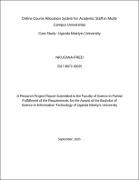Online course allocation system for academic staff in multi- campus Universities
Abstract
This project is about the design and implementation of an Online Course Allocation System for
Academic staff for Uganda Martyrs University to replace the currently used manual system.
Course allocation involves the scheduling of a certain number of academic staff (lecturers) to
teach courses over a definite period. It is usually done by the head of the department which takes
into consideration the teaching load per week and contact hours for each academic staff
according to their preferences. This process is costly and prone to human errors. Moreover, there
is also a lot of repetitiveness were several lecturers can be allocated the same course. As well
there are challenges in assigning the right course to the right lecturer. As a result, there are many
allocation mistakes where some lecturers may be overwhelmed, while others would be
underutilized. The project was therefore aimed at reducing the time and costs incurred during the
course allocation process, as well as enhancing the work of allocating courses to the academic
staff at this university.
A study was carried out to justify the relevance of the new system. The researcher followed a
design-oriented research approach to collect and analyze the required data. Questionnaires,
interview guides, and document analysis were used to collect the required data. The data
collected was analyzed using frequency tables and the results of the analysis of this data were
also presented. The analysis was aimed at investigating the various loopholes of the current
system to come up with the functional, non-functional, and user requirements of the new system.
During the study, it was found out that the currently used systems is too tedious and also prune to
human errors hence a need to come up with a new system.
To solve the above problems, models representing the system were designed and implemented.
Here several methodologies and tools were used. Dreamweaver embedded with HTML and PHP,
UML, JavaScript, CSS MySQL, and Ms. Vision was also used through the planning, analysis,
design, and implementation of the new system. The researcher used the prototyping technique to
come up with the system which was tested and validated for the expected performance and
ensure that the required requirements were met


